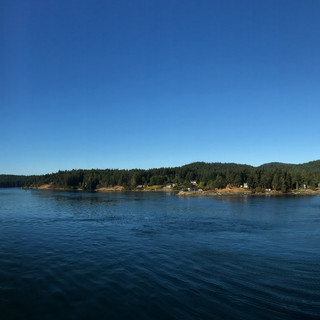On to Victoria
- Rex Ballard

- Sep 12, 2017
- 6 min read
Hi there everyone. Sorry, I'm a little late with this post. It was a long day yesterday and I didn't have it in me to write this up.
Monday - Sept 11, 2017
Elisa and I got up early this morning because we had a reservation for the 9:00 am ferry that would take us from the Tswassen Ferry terminal just outside of Vancouver over to Vancouver Island so that we could visit Butchart Gardens and the town of Victoria. When we checked in, the folks in the office said to allow ourselves about an hour to get to the ferry terminal due to morning traffic. When I booked our reservations on-line, we were advised to arrive between 1/2 to 1 hour prior to our scheduled departure. So, all this meant we needed to plan to leave the campground by 7:00 am and by golly, we actually did it. We were in the car and on our way by 7:05 am.
The trip out to the Tswassen terminal took us about 50 minutes. We weren't sure how things worked out there. Other times when we have taken a ferry boat we had to line up our car and then make a long walk to a ticket office to purchase our passage and then make the long walk back to the car. Here in Canada, they have taking the ferry down to a real model of efficiency. As you pull up to the terminal, it is like a toll plaza for a bridge. There are many lanes and they are marked by destination. You simply pull up to a window with your destination and an attendant collect the fare and tells you what lane you need to be in to take your vehicle onto the ferry. In the States, we would then have to hand over the keys to an attendant that would drive the car onto the ferry and we would walk on board the boat. Here the efficiency is top rate. You are guided where to drive your car onto the ferry and where to park it. No fuss - no muss - easy peasy. In fact, since it only took us 50 minutes to make the trip, the attendant asked us if we wanted to take the 8:00 am ferry and we were only 5 minutes before departure time. We said, "sure". We drove right on board the boat, parked and then walked up to the passenger deck. The ferry is large and we were parked next to large semi-trucks with huge trailers along with RVs of all sizes and other cars. The ferry had 2 decks for vehicles with each deck holding 50 to 60 vehicles. When we walked to the passenger decks the seats were very nice and comfortable, there was a full service cafeteria, gift shop and a number of restrooms. There was a wide outer deck, where passengers could stroll and enjoy the scenic beauty of the Strait of Georgia. The trip takes about 1-1/2 hours and it is very smooth and scenic.
When we arrived at Swartz Bay on Vancouver Island, the ferry operations were just as efficient as they were for embarkation. We were advised to return to our vehicles when we were about 15 minutes away from docking and not start our cars until we saw the lead vehicles begin to pull forward - this eliminates fumes from collecting on the vehicle decks. We then drove off, as easily as we drove on and the road way lead us directly onto the main road that takes you from Swartz Bay to Victoria. The drive to Butchart Gardens was about 20 minutes from Swartz Bay and traffic was light and things moved quickly. I visited Butchart Gardens with my parents about 50 plus years ago when I was just a kid and I really didn't know what to expect. All I knew was that there were lots of gardens, plants and flowers. Typically, this is not the type of thing that excites me, but I know it pleases Elisa. She were especially interested because her Brother Angelo, who suffers the aftereffects of a couple of different strokes can not travel, and he is an avid gardener and very knowledgeable about plants. Elisa was very determined to chronicle the visit to Butchart Gardens with photographs so that she could share it with her Brother when we get back home.
The Butchart Gardens are the handiwork of Jennie Butchart. She and her husband Robert moved their Portland cement business from Ontario, Canada to the west coast in 1888 to take advantage of the building boom taking place at the time along with the availability of limestone quarries that are critical to making cement. They set up business on Vancouver Island near the western most city of Victoria, Canada, the Provincial Capital of British Columbia. The business grew and prospered and they established a large estate near one of their quarries. Jennie Butchart enlisted the help of a Japanese garden designer, Isaburo Kashida, who had come to the region to design a garden at a nearby park on the Island. The park was very popular and it became the "In" place to be seen. Jennie, asked Kashida to help her design a garden on the Butchart estate. Jennie's garden continued to expand and it soon became the site of many social gatherings and Jennie soon began allowing entry into the gardens to the general public. Soon the original Japanese garden were expanded to include Italian gardens, Rose Gardens and the Sunken Garden that was built in an exhausted limestone quarry.
In 1939, the Butchart's who were advancing in age, gifted the gardens to their grandson, Ian Ross who was 21 years old at the time. Ross would take over the running and design of the gardens for the next 58 years. To this day, the gardens are privately owned by the Butchart family and it continues to be run by the daughter of Ian Ross. It has been designated a National Historic Treasure and is visited by about 1 million people from around the world annually. An surprising fact that I learned is that thousands of plants across the entire park are replanted approximately 4 time per year so that the gardens are always in bloom to the pleasures of visitors that come to the park year around. That is an incredible amount of work.
The cost of entry was $32 C/person to enter the park and neither of us were disappointed with what we saw. Although, gardens are not the first thing on my list of things to do, I really enjoyed our visit to Butchart Gardens and would highly recommend it to visitors to the BC area.
After our visit to Butchart Gardens, we headed into the city of Victoria. Victoria is relatively remotely located on the very west end of the Province. It is relatively isolated from the rest of the Provence and reachable primarily by ferry or sea plane from either Vancouver or Seattle. In spite of its remoteness, it is the Provincial Capital of British Columbia. It is also home to the Royal British Columbia Museum. We decided to drop in and pay the museum a visit based on solid reviews on Trip Advisor. The Museum sits in the heart of Victoria directly adjacent to the main Government buildings. The entry admission is $17C per person, not including admission to the IMAX theater, which is extra. This museum details the natural history of British Columbia and this day included interesting displays on the original native inhabitants of the region. There were over 200 different tribes that occupied the region prior to European and British settlers arriving in the area. It is estimated that the Native population in the early 1800's may have numbered over 800,000 inhabitants. These 200+ tribes had their own customs and in many cases their own language. The tribes were sustained by the salmon that ran rich through the streams and rivers. For the most part, these tribes coexisted with the new-comers peacefully. However, the new-comers brought with them western diseases such as small pox. These diseases would end up decimating somewhere between 80% - 90% of the Native population. During expansion of the Northwest, the Natives were often moved from their resource rich homelands onto reservations. Other efforts were launched by the western settlers to assimilate the Natives. Many Government policies actively promoted the illumination of heritage culture until legislation was passed within the last 25 years that was designed to preserve and promote the preservation of the Indian culture.
The Museum also include an interesting displays on the history of industry in the region that were focused on Canada's rich natural resources, including forestry and mining. We could have easily spent more than the 2 hours we did at the Museum


































































Comments